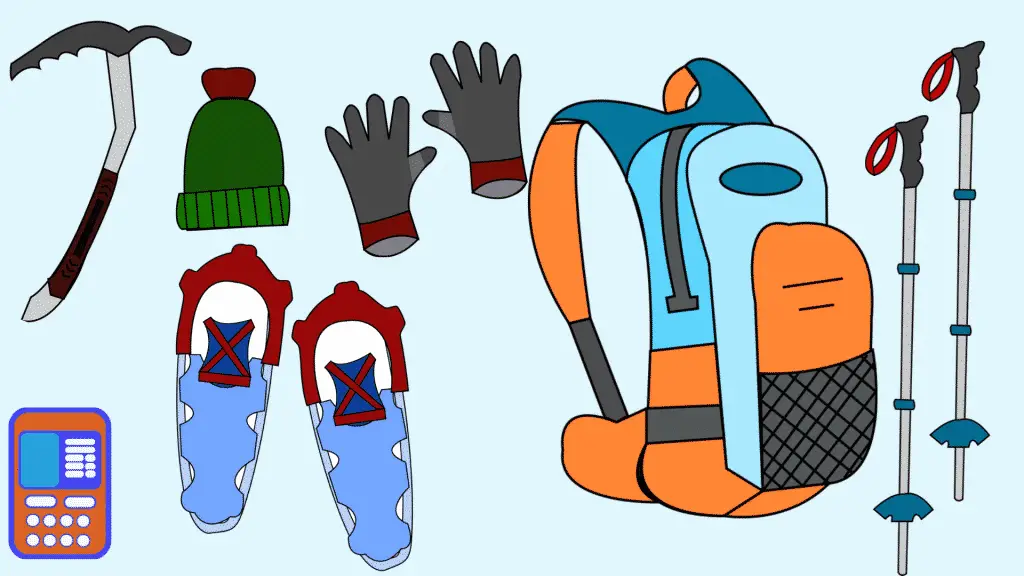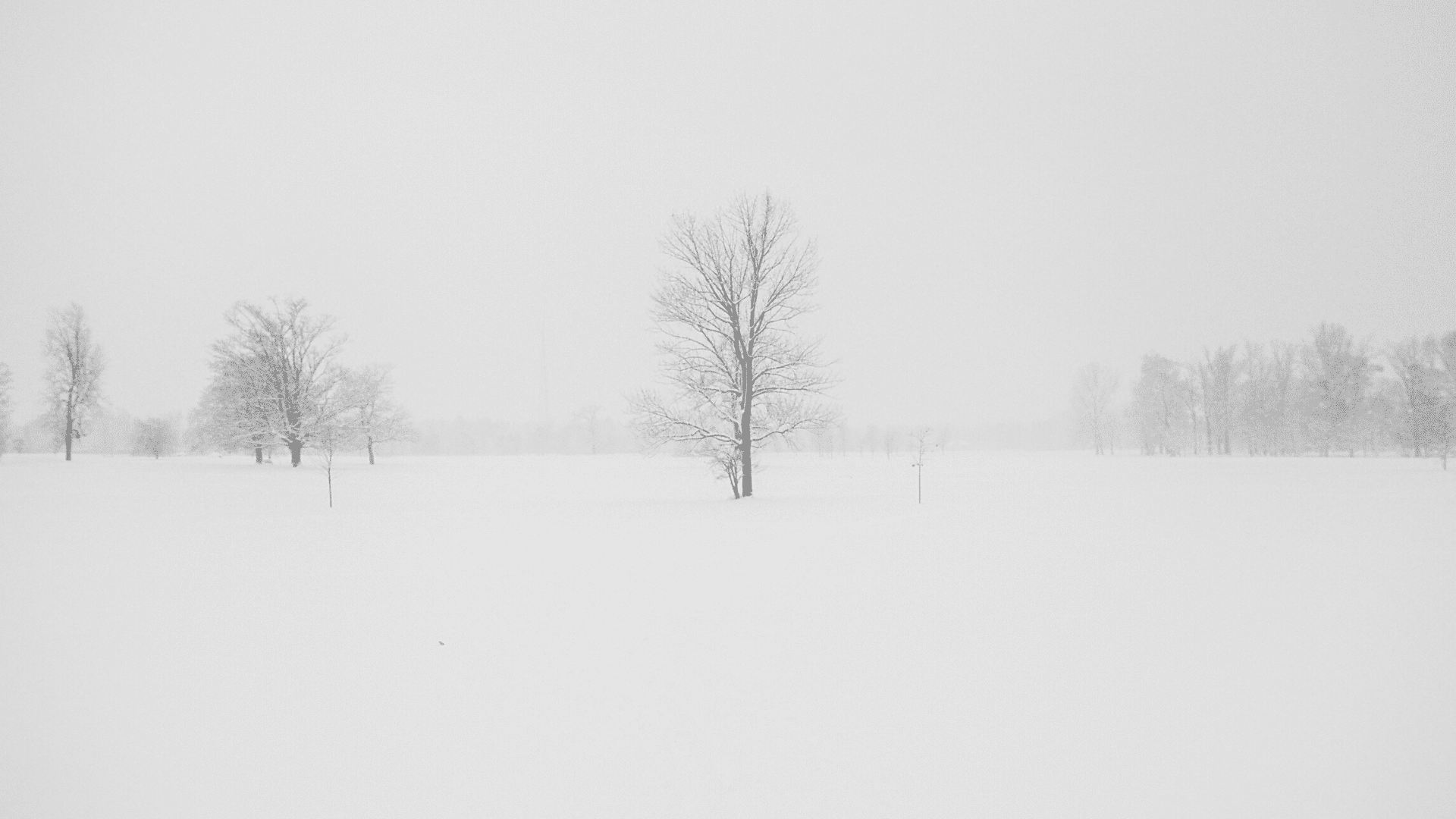Most hikers and backpackers like to keep it easy by only hiking in mild months, but we’re not like most hikers. There’s just something about hiking through the winter months that you can’t describe. It’s all about facing those hard challenges when everybody else is sitting at home watching tv.
Don’t take 6 months of the year off just because it’s a little cold. If you prepare yourself and buy the right gear you can get out on the trail in even the harshest weather.
Table Of Contents
How to Hike in Deep Snow

Going for a winter hike is all about preparation. You need to make sure you have all the right gear, dress appropriately, check the weather, plan your route and follow a few safety features to make sure you don’t freeze to death(do you know what temperature you freeze to death?)
Everything You Need For Short Hikes
Short day hikes all boil down to common sense. You really don’t need all that much gear for a short 2-3 hour hike after work(multi-day backpacking trips are a different story altogether).
I’m sure you don’t think twice about heading down to your local park for a short hike during the summer. Don’t overthink it! Although you might need extra insulating layers getting out for the day shouldn’t be all that difficult. Plan for warmth and just get out on the trail if you’re starting to get cabin fever.
When planning for a short 2-3 hour day hike you shouldn’t need much. Go out and buy a quality pair of waterproof hiking boots(consider going up 1/2 size to fit warmer socks), waterproof pants, extra insulating layers, and hiking sticks or just a single walking stick to test the ground and stabilize you on ice(these trekking poles are all you really need).
Dress For The Snowy Weather
What you choose to wear on the trail will make or break your trip. If you don’t layer up appropriately you’ll be miserable. Check out my post comparing Merino Wool and Polyester Base Layers.
Cottin is the cause of most of our problems on the trail. We’ve been fooled into believing that cotton can be worn in any environment and that’s dead wrong. Cotton is terrible in both extreme cold and heat. The biggest problem is cotton holds moisture and takes forever to dry.
Instead of wearing cotton stick to wool and synthetic base layers. Personally, I prefer to wear Merino Wool base layers over synthetics. Merino Wool is moisture resistant, thermoregulating, anti-bacterial and odor eliminating. It’s the perfect material for physical activity in the winter(Icebreaker makes affordable Merino-Wool base layers).
As a mid-layer I prefer synthetic polyester blends because they are more durable. Fleece jackets are perfect for most applications(this is what I’m talking about). Fleece mid-layers are durable, waterproof and breatheable. It’s perfect for most outdoor applications. It’s heavy enough to wear on its own and light enough to be worn under a heavy outer jacket.
Wear thermal base layers(preferably merino wool or synthetic) underneath your walking pants. For some reason, the waffle design seems to keep me warmer.
Never wear jeans on a hike! Denim will get wet, freeze and make you feel miserable. Instead go with waterproof, moisture-wicking pants made out of synthetic material. I really like the budget offerings from REI, Columbia and Marmot(these Marmot pants are currently my favorite although you will need a base layer).
If you know the temperatures will get down into the teens-subzero you’ll want secondary pants. Cheap snowboarding pants are some of the best options on the market(Arctix is an affordable option).
Bring Extra Gloves, Hats and Gaiters

Frostbite is the biggest danger on short winter hikes. Hypothermia really won’t be a concern unless you get trapped for an extended period of time. Frostbite is the real danger when temperatures reach the low teens and it typically affects your toes, fingers, and face(extremities leave heat fast).
Bring along a couple pairs of gloves. Merino-Wool is better for dexterity, but they make great liners. Synthetic gloves are much better as an outer-layer since they can be waterproof. Waterproof ski-mittons are really good in the extreme cold.
Everybody knows that we lose most of our body heat through our heads. Since you’re physically working out you need to find a hat with moisture-wicking properties. When choosing head gear don’t forget to protect your face and neck. You should definitely have a high-quality balaclava or neck-gaiter available in your pack.
Protect Your Feet
All backpackers understand the importance of protecting their feet, but nobody knows how. What you wear on your feet is incredibly important. Lightweight hiking boots aren’t going to cut it in the winter months.
You need a boot with a sturdy sole, and high sides to keep out snow(they should be able to handle crampons). Those boots paired with tall gaiters will prevent snow from entering your shoes.
In most cases, frostbite isn’t solely caused by extreme cold. It’s actually a result of poor circulation caused by jamming extra pairs of socks in tight boots. When you cut off circulation to your feet your body can no longer pump warm blood through your feet to warm them up.
One pair of hiking socks like these Darn Tough Merino wool socks will keep you warmer than multiple pairs of even the thickest cotton socks. Merino wool is the best choice in the winter because they’ll be warm even when soaked in sweat.
Bring Eye Protection
Sunglasses will work under most circumstances to prevent snow glare(snow blindness). When walking in the winter snow glare can be a serious problem. Extreme wind can be an even bigger problem.
Personally, I don’t like to wear goggles, but I always have a pair in my pack. When blizzards kick up you need to be able to keep your eyes open. You can quickly run into problems in low visibility.
Use Walking Poles

If you’ve never used walking poles during the summer this is the time to start. Walking poles will allow you to carry more gear, stabilize your load, take weight off your knees/back and help you check for covered up obstacles in the snow.
Just make sure you practice using poles before heading out on the trail. When you’re knees deep in the snow you shouldn’t be messing around with poles for the first time. Know how to adjust your poles for flat terrain, and going up/down hillsides.
Learn about Snowshoes, Crampons and Microspikes

If you don’t own a pair of snowshoes you’re seriously missing out. Snowshoes allow you to travel on top of the snow and comfortably carry more gear. They allow you to travel in situations where snow isn’t packed down. With weight evenly distributed over a large surface area you won’t sink into the snow.
Check out my post on using snowshoes, crampons and microspikes
Crampons and microspikes should only be used on heavily packed down snow/ice. With jagged teeth crampons bite into the ice preventing you from slipping and sliding. Just remember that crampons will wear you down and significantly slow down your pace(though you won’t get injured). In my experience Black Diamond seem to be the best for the price.
Microspikes(like these) will be easier to walk on, but they aren’t as effective. Unless you’re traveling on extreme hillsides microspikes are all you should need.
Hiking in Snow
Walking through snow can be a slow challenging process. Make sure you give yourself extra time to get back before dark. If you walk 3 miles per hour in the summer expect to walk 1 in the winter.
- Follow Your Lead: If you’re walking with a friend(which I highly recommend) follow his footsteps. Walk in the footsteps of the lead walker and occasionally switch positions to reduce fatigue.
- Be Careful in Hills: Hills can be absolutely treacherous during the winter months. Even if you ignore the risk of snow slides, you end up with soft powder on top of hard ice. It’s easy to slip and fall(walk-in zigzags can prevent long falls and be prepared for slips)
- Snow Axe and Crampons: Pack a snow axe and crampons in your pack if you’re expecting ice. You probably won’t need a snow axe on flat surfaces, but crampons will come in handy. Check out my crampon guide and pick up a pair of these bad boys.
- Use Your Hiking Sticks: Use your walking sticks to test the ground and stabilize yourself on even snow. Remember that soft deep snow could be covering up ice.
Ascending/Descending Hills
Always carry an ice axe if you’re traveling up/down steep slopes. Learn how to use the axe and make sure you can quickly grab it. My two favorite brands are the Petzl Ice Axe and Black Diamond Axe
When traveling uphill the key is to kick into the snowbank. This is when I toss on my crampons and really dig into the hillside. If you don’t have crampons consider walking into deep snow. Trampled down snow from previous travelers will always become hard and icy.
Walking downhill is almost always harder than traveling uphill. When traveling downhill, you have a few options. You have the plunge step, glissade and boot sliding on your feet. Regardless of the method you choose make sure your ice axe is handy.
Using the plunge step is the safest way to travel downhill in the snow. Lift up your leg, straighten it out and plunge your heel into the ground. Lean forward and prepare to take the next step making sure you don’t go too fast(it’s easier said than done). Keeping a steady pace will prevent you from falling into deep snow.
On seriously difficult hillsides the safest way to get down is using the glissade method. Sit down on the ground and let yourself slide down the slope in a controlled manner. Take out your ice axe and use it as a brake/rudder. Test the slope and take a controlled descent.
Be Mindful of Geological Dangers
When there’s snow on the ground you have lots of dangers that you don’t normally have to deal with. I’m not even talking about the normal risks like hypothermia, frostbite etc. There are geological features that you just can’t see when covered with snow.
It’s all about being aware of natural hazards. Frozen rivers can cover with snow, overhangs/bluffs can slip and cause avalanches, deep ditches can be covered with snow.
- Deep Holes: Deep holes can be found anywhere on the trail, but they’re most common around large trees. Use hiking poles/sticks to test your footing in deep snow.
- Watch Ridgelines: Be very careful when walking along cliffs/ridgelines. Snow can obscure the edge and give in as you walk.
- Snow Blocks Rivers: Soft snow can cover small streams and creeks preventing solid ice from forming on these surfaces. Stepping on this snow/ice can result in wet feet.
- Deep Ditches/Gullies: Blowing wind can quickly fill in ditches with soft/fresh powder leaving only a small indent behind. Never trust a small dip because it might be deeper than it seems.
- Avalanches: If you’re walking in areas that are prone to avalanches stay alert. Past avalanches can result in large drifts of snow-covered debris to trip on.
Planning is Key to Winter Hiking Safety
Seasoned winter hikers and backpackers all have one thing in common. They are all obsessed with planning. From obsessively picking out each individual piece of gear, to planning their roots, and watching the weather. Winter backpackers and hikers don’t leave anything up to chance.
When their trip is so thoroughly planned they can quickly adapt when problems occur. They plan ahead, bring extra warm gear and make sure there are emergency rations just in case.
Camping in the winter isn’t about creating heat through fires and fuel, it’s about preserving heat through insulation. Carry a big 55-65 liter pack plan for weather 15-30 degrees below the expected conditions.
You need to have enough room to carry all those extra layers when you aren’t wearing them. Plus your pack should have exterior straps to stow ropes, axes etc.
Watch The Weather
Watch the weather for the entire week leading up to your trip. Keep an eye out for strange weather conditions that could drastically change the weather overnight.
Check the weather 48 hours before your hike and value your safety over the trip. Don’t go out into the wilderness if you aren’t 100% certain about the weather. With modern technology, there’s no excuse for venturing out into dangerous weather.
Knowing what the conditions are like before your trip is great, but nowadays you can actually check your phone while on the trail. You can be miles away from civilization and your phone will show you a live forecast(you might need a satellite phone in extreme backcountry).
If the weather looks like it could change for the worse limit your hiking distance and plan on heading back to safety.
Plan Your Trip Around Daylight Hours
Throughout the winter you’re limited by the amount of sunlight in a day. Even if you wake up early your still limited to about 7 hours on the trail. Be realistic about how far you can actually travel in a day.
Most hikers won’t be able to travel faster than 2 mph in deep snow. It’s so much harder to travel in the snow than on flat ground. Throw in a little bit of elevation and you’ll be even slower.
Finish Your Day Early
Make sure you have a destination in mind that you can reach hours before night time. I don’t care how fast you travel during the summer, you’ll be slower than you think. You have to carry more gear, walk through difficult terrain and camp setup will be much harder.
Reconsider That Solo Trip
Winter hiking/backpacking is a whole different ball game. Even experienced hikers can quickly get into trouble during the winter. With weather drastically changing from one day to the next it’s hard to pack the right gear.
If it’s your first time hiking in the winter, go somewhere familiar and bring a friend. When first starting out consider short day/weekend hikes and bring along friends(hopefully experienced backpackers).
Remember that you always have safety in numbers on backpacking trips. You have twice as much gear to rely on and twice the experience. Plus it’s always more fun to bring a friend.
Tell Somebody Where You’re Going
So many hikers could have been saved if they only told a family member where they were traveling. Always let somebody know where you’re going and when you expect to return.
This is good practice even in the summer, but it’s especially important in the winter when the weather can change in an instant. Make sure your phone is fully charged and bring a battery backup. Before heading out find the number to call mountain rescue and bring along signal flares just in case.
If you’re traveling in the extreme backcountry you might want to consider a satellite phone with GPS navigation. You can make calls anywhere in the world and find your way if you get lost.
You might also want to consider bringing along an Avalanche Beacon/Transceiver if you’re traveling in hilly backcountry. Some forestry departments will also recommend avalanche airbags, but those are too cumbersome for backpacking in my opinion.




